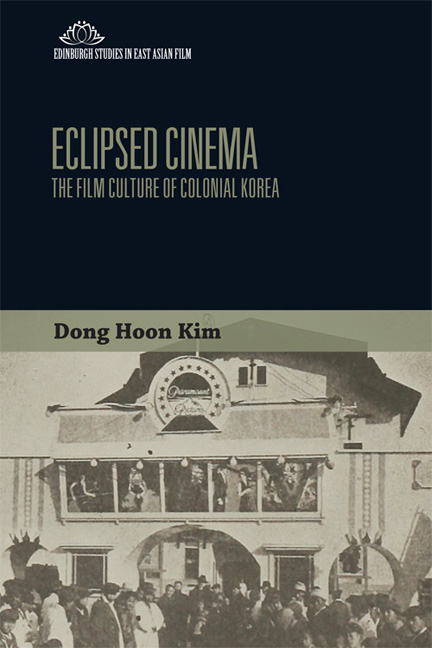Book contents
- Frontmatter
- Contents
- List of Figures
- Acknowledgements
- Introducing Joseon Cinema: the Question of Film History and the Film Culture of Colonial Korea
- 1 The Beginning: Towards a Mass Entertainment
- 2 Joseon Cinema, Cinematic Joseon: on Some Critical Questions of Joseon Cinema
- 3 Migrating with the Movies: Japanese Settler Film Culture
- 4 Colonial Film Spectatorship: Nationalist Enough?
- 5 Film Spectatorship and the Tensions of Modernity
- Conclusion: Integrating into the Imperial Cinema
- Notes
- Appendix
- Bibliography
- Index
Conclusion: Integrating into the Imperial Cinema
Published online by Cambridge University Press: 03 January 2018
- Frontmatter
- Contents
- List of Figures
- Acknowledgements
- Introducing Joseon Cinema: the Question of Film History and the Film Culture of Colonial Korea
- 1 The Beginning: Towards a Mass Entertainment
- 2 Joseon Cinema, Cinematic Joseon: on Some Critical Questions of Joseon Cinema
- 3 Migrating with the Movies: Japanese Settler Film Culture
- 4 Colonial Film Spectatorship: Nationalist Enough?
- 5 Film Spectatorship and the Tensions of Modernity
- Conclusion: Integrating into the Imperial Cinema
- Notes
- Appendix
- Bibliography
- Index
Summary
In October of 1936, the completion of Meijiza, a new six-storey, giant-sized movie theatre (including two underground floors), which could accommodate fifteen hundred spectators, delighted film aficionados in Seoul. Ishibashi Ryōsuke, a highly successful Japanese businessman based in Seoul who owned the Maru Building, one of the landmark buildings in Meiji-machi that housed the luxurious Maru cafe and many other business entities, initiated the project, when Shochiku studio granted him exclusive distribution and exhibition rights to its films. The establishment of Meijiza was part of the deal made with Japanese Shochiku studio, as detailed in Chapter 3. The theatre was designed by Japanese settler architect Tamata Kitsuji who designed the renovated buildings for Danseongsa (1935) and Koganekan (1936). As a Shochiku-affiliated theatre, Meijiza was primarily a movie theatre but served a variety of purposes, also accommodating stage plays, kabuki and other performing arts. It was located in Meiji-machi (today's Myeong-dong), one of the commercial centres of the Japanese area South Village, to which Japanese settlers popularly referred as ‘Ginza of Joseon’, and quickly became a landmark of Seoul. The theatre became co-managed by Shochiku and was renamed Shochiku–Meijiza in August 1941. Meijiza remained the largest theatre in Joseon until the end of the Japanese occupation, and the legacy of Meijiza's grand size and elegant European-style facade and interior was sustained long after the colonial period. Meijiza was renamed Sigonggwan in 1947 and brought under the management of the city of Seoul. The theatre survived the Korean War (1950–53) and, after the war, accommodated The National Theatre of Korea from 1957 until 1973 when the National Theatre moved to its current location in the Jangchung-dong area. To finance the construction of a new national theatre, the government sold the theatre to a private business. After being used by private companies for several decades, the Ministry of Culture and Tourism purchased the building in 2004 and announced its plan to restore the building as a national theatre.
- Type
- Chapter
- Information
- Eclipsed CinemaThe Film Culture of Colonial Korea, pp. 229 - 235Publisher: Edinburgh University PressPrint publication year: 2017



